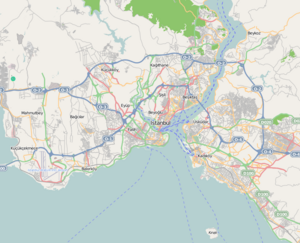Walls of Constantinople
| Walls of Constantinople | |
|---|---|
| Istanbul, Turkey | |

Map showing Constantinople and its walls during the Byzantine era
|
|
| Coordinates | 41°00′44″N 28°58′34″E / 41.01224°N 28.976018°E |
| Type | Walls |
| Height | Up to 12 m |
| Site information | |
| Owner | Turkey |
| Controlled by | Roman Empire, Byzantine Empire, Latin Empire, Ottoman Empire |
| Open to the public |
Yes |
| Condition | Land walls partly ruined, restoration work under way; sea walls largely torn down |
| Site history | |
| Built | 4th–5th centuries, with later restorations and additions |
| Built by | Septimius Severus, Constantine I, Constantius II, Theodosius II, Heraclius, Leo V, Theophilos, Manuel I Komnenos, Justinian I |
| Materials | Limestone, brick |
| Battles/wars |
Avar siege of 626, First and Second Arab sieges, Revolt of Thomas the Slav, Fourth Crusade, Second and final Ottoman siege |
| Type | Cultural |
| Criteria | i, ii, iii, iv |
| Designated | 1985 (9th session) |
| Part of | Historic Areas of Istanbul |
| Reference no. | 356 |
| State Party |
|
| Region | Europe and North America |
 |
|
| This article is part of the series on the military of the Byzantine Empire, 330–1453 AD | |
| Structural history | |
|---|---|
| Byzantine army: East Roman army, Middle Byzantine army (themes • tagmata • Hetaireia), Komnenian-era army (pronoia), Palaiologan-era army (allagia) • Varangian Guard • Generals (Magister militum • Domestic of the Schools • Grand Domestic • Stratopedarches • Protostrator) | |
| Byzantine navy: Greek fire • Dromon • Admirals (Droungarios of the Fleet • Megas doux) | |
| Campaign history | |
| Lists of wars, revolts and civil wars, and battles | |
| Strategy and tactics | |
| Tactics • Siege warfare • Military manuals • Fortifications (Walls of Constantinople) | |
Avar siege of 626, First and Second Arab sieges, Revolt of Thomas the Slav, Fourth Crusade, Second and final Ottoman siege
The Walls of Constantinople are a series of defensive stone walls that have surrounded and protected the city of Constantinople (today Istanbul in Turkey) since its founding as the new capital of the Roman Empire by Constantine the Great. With numerous additions and modifications during their history, they were the last great fortification system of antiquity, and one of the most complex and elaborate systems ever built.
Initially built by Constantine the Great, the walls surrounded the new city on all sides, protecting it against attack from both sea and land. As the city grew, the famous double line of the Theodosian Walls was built in the 5th century. Although the other sections of the walls were less elaborate, when well-manned, they were almost impregnable for any medieval besieger, saving the city, and the Byzantine Empire with it, during sieges from the Avars, Arabs, Rus', and Bulgars, among others. The advent of gunpowder siege cannons rendered the fortifications vulnerable, but cannon technology was not sufficiently advanced to capture the city on its own, and the walls could be repaired between reloading. Ultimately the city fell from sheer weight of numbers of the Ottoman forces on 29 May 1453 after a six-week siege.
...
Wikipedia

